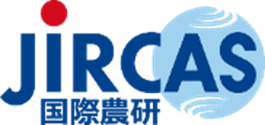研究成果
Soil Carbon Sequestration Effects Revealed from Over 45 Years of Long-Term Field Experiments
—Contributing to Both Reduced Environmental Impact and Improved Soil Fertility in Tropical Regions—
March 6, 2025
|
Main Points
|
Overview
JIRCAS and Thailand’s Department of Agriculture have jointly analyzed data from over 45 years of long-term field experiments on the application of chemical fertilizers and organic matter. Their findings clarify how combined management practices in upland fields can enhance soil carbon sequestration.
Soil is the largest terrestrial carbon reservoir, and even slight fluctuations in soil carbon stocks can significantly affect the global carbon cycle. Long-term field trials—where management practices are consistently observed on the same land over decades—are critical to understanding soil carbon dynamics. However, such trials are rare in tropical regions, making it difficult to accurately assess the long-term impacts of agricultural management on soil carbon storage.
This study examined long-term experiments at three sites in Thailand focused on cassava cultivation. Using multivariate statistical analysis, researchers quantified the effect of various fertilizer and organic matter combinations on soil carbon stocks. The results showed that combined application of chemical fertilizers and organic matter (such as crop residues and compost) significantly increased soil carbon levels. Compost application, in particular, was found to be more effective than crop residues alone.
Soil type was a major factor. In clayey soils, carbon tended to accumulate in the surface layer, while in sandy soils, significant carbon accumulation occurred throughout the soil profile up to 1 meter deep. This suggests that evaluations should extend beyond the top 30 cm used by the IPCC (Intergovernmental Panel on Climate Change) and include deeper layers to more accurately assess sequestration potential.
Using structural equation modeling, the study further demonstrated that organic matter application increased soil carbon, and in sandy soils, also led to improved fertility and higher crop yields. These results support the development of improved soil carbon models for tropical regions and reinforce the role of soil carbon sequestration as a viable climate change mitigation strategy.
Looking ahead, the researchers plan to expand their analysis of long-term trial data and strengthen collaborations between Japanese and Thai institutions to enable large-scale assessments of soil carbon storage potential. The outcomes are expected to contribute significantly to building tropical soil carbon dynamic models, promoting sustainable agriculture that balances environmental preservation and productivity enhancement.
The results of this research were published in the electronic version of the international scientific journal "Land Degradation & Development" (October 3, 2024, Japan time).
- Funding
- Operational Expenses Grant Project: "Development of comprehensive agricultural technologies for climate change mitigation and adaptation in Monsoon Asia"
Publication
- Authors
- Somrutai Tancharoen, IWASAKI Shinya, WATANABE Takeshi, Suphakarn Luanmanee, Wanida Nobuntou, Wanlee Amonpon, Netirat Chumsuwan, Kobkiet Paisancharoen, Saowaree Bumrung, MATSUMOTO Naruo
- Paper Title
- Carbon Sequestration and Soil Fertility Management in Sandy and Clayey Soils Revealed by Over Four Decades of Long-Term Field Experiments in Thailand
- Journal Title
- Land Degradation & Development
DOI: https://doi.org/10.1002/ldr.5310
For Inquiries
JIRCAS President: KOYAMA Osamu
- Program Director:
- HAYASHI Keiichi
- Research Staff:
- IWASAKI Shinya (Rural Development Division)
- Press Coordinator:
- OMORI Keisuke (Head Information and Public Relations Office)
Email: koho-jircas@ml.affrc.go.jp


